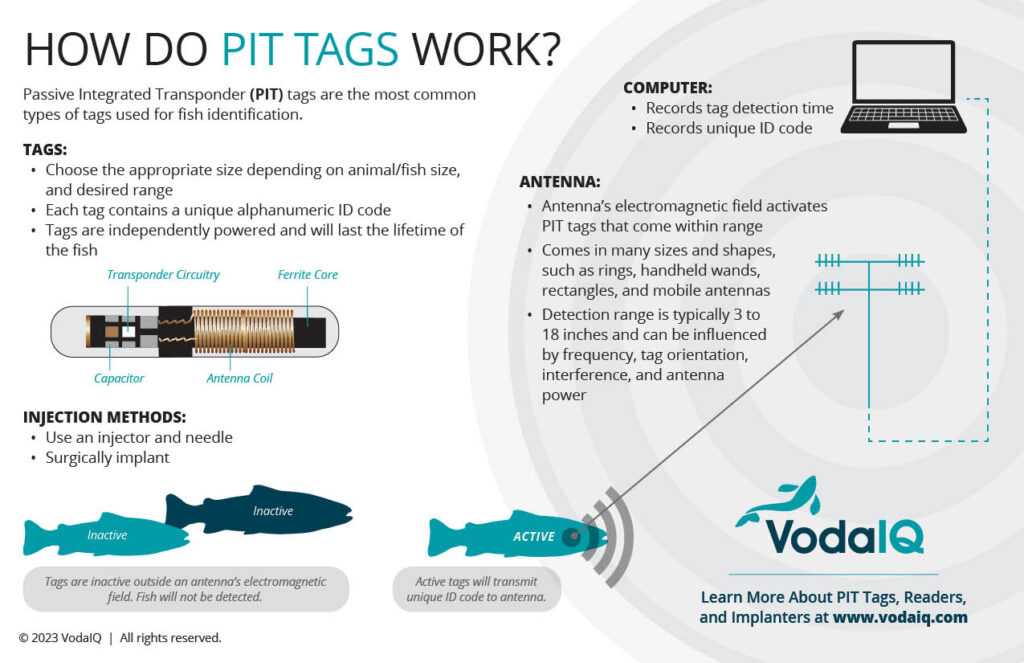FREQUENTLY ASKED QUESTIONS
RFID (radio frequency identification) is a form of wireless communication that incorporates the use of electromagnetic or electrostatic coupling in the radio frequency portion of the electromagnetic spectrum to uniquely identify an object, animal or person.
Every RFID system consists of three components: a scanning antenna, a transceiver or reader and a transponder or PIT Tag or Chip. When the scanning antenna and transceiver are combined, they are referred to as an RFID reader or interrogator. There are two types of RFID readers — fixed readers and mobile readers. The RFID reader is a network-connected device that can be portable or permanently attached. It uses radio waves to transmit signals that activate the tag. Once activated, the tag sends a wave back to the antenna, where it is translated into data.
The transponder is in the RFID tag itself. The read range for RFID tags varies based on factors including the type of tag, type of reader, RFID frequency and interference in the surrounding environment or from other RFID tags and readers. Tags that have a stronger power source also have a longer read range.
The RFID or EID devices most widely used in animals are passive. Passive Integrated Transponder (PIT) Tags are electronic, implantable microchips used in Wildlife and Marine Biology applications. They are designed for implantation into any species that needs to be tracked in order to gain valuable research data. Species such as salmon, sturgeon, musky, turtles, frogs, birds, bats, rhinoceros, elephants, kudu and other animal can be identified using these standard PIT tags. For specialized applications, such as animal security or theft prevention of precious animals.
A Passive Integrated Transponder, or PIT, are tracking tags that do not require power. Instead, they have an internal microchip that is activated when it passes close to a special antenna. The antenna is connected to a computer that records the identity of the tag and the time that it passed by the antenna. The reader powers or excites the tag circuitry by radio frequency induction and receives the code back from the tag. Radio frequency identification does not require line of sight, tags can be read as long as they are within the range of a reader.
The use of PIT – or passive – tags for animal identification and research provides many benefits including the reduction of error in recording data, rapid data collection and long term reliability. The value of PIT tags has been successfully demonstrated in studies of mark and recapture, survival, movement, behavior and distribution for a variety of species. In addition, PIT tags are use at hatcheries and aquaculture facilities as part of breeding programs, and for tracking results of feed programs. All PIT tags use the ICAR standard for tag codes, insuring no duplicate tag codes.
PIT tag technology and development is constantly evolving. There are currently three basic tag frequencies. The 400-kHz tag was one of the first developed and it is still in use today, though readers are getting scarce. These tags have a limited read range. As microchip technology evolved, the 125-kHz and the ISO 134.2-kHz tags became available. Compared to the older 400-kHz tags, they have a much better read range and reduced read time. The ISO 134.2-kHz tag was developed to meet international standards for code format. If you are starting a new project and working with different agencies or organizations the tag type and equipment should be compatible. Most readers are capable of detecting both 125-kHz and ISO 134.2-kHz frequencies.
Read Range is defined as the distance from which a tag can be read is called read range. Many factors contribute to the read range of passive tags including operation frequency, antenna power, tag orientation and interference from other devices. Low frequency tags are detected in milliseconds at close range from a few inches to about a foot (0.33 meter) in distance. PIT Tags can be read through materials such as soil, wood and water. Ferrous metals and noisy environments can cause interference between the electromagnetic communication of the reader and tag.
The distance from which a tag can be read is the read range. There are environmental and application factors that may limit read range. Optimal conditions exist in an air environment with the tag placed perpendicular to the antenna field. Factors such as tag frequency, electromagnetic noise, metals and antenna power may affect the read range. Typically, the larger the tag the better the read range. Some tag and antenna combinations can read passive tags as far away as 18 inches. Most read ranges using hand-held readers are 3 to 9 inches depending on the reader.
Voda IQ offers a variety of PIT tag sizes and researchers select them based upon their research project. The Voda IQ HQ12.5 is designed specifically to have one of the best read ranges of any 12mm PIT tag and the IC 4305 that allows it to perform in high noise environments or EMI.
Yes, Voda IQ PIT Tags can be read by readers from other manufacturers as long as the reader is designed for the same frequency of the tag used.


